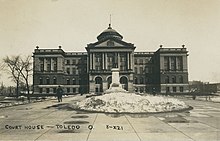Lucas County, Ohio
[2] Its county seat and largest city is Toledo, located at the mouth of the Maumee River on the lake.
[3] The county was named for Robert Lucas, 12th governor of Ohio, in 1835 during his second term.
[4] Its establishment provoked the Toledo War conflict with the Michigan Territory, which claimed some of its area.
On August 20, 1794, near the site of the present-day town of Maumee, American forces led by General Anthony Wayne won a decisive victory over allied Indian forces at the Battle of Fallen Timbers after years of conflict in what was known as the Northwest Indian War.
The defeat of the Native forces resulted in the opening of the entire Northwest Territory for white settlement.
Northwest Ohio was occupied chiefly by villages and bands of the Odawa people, who had trading relations with the French at Fort Detroit since 1701.
They ceded much of that territory in the Treaty of Greenville but retained control of lands along the Maumee River until after the War of 1812.
The last Odawa band, that of Ottokee, grandson of Chief Pontiac, left the Maumee River area for Kansas in 1839.
At that time, both Ohio and Michigan Territory claimed sovereignty over a 468-square-mile (1,210 km2) region along their border (see Toledo War).
When Michigan petitioned Congress for statehood in 1835, it sought to include the disputed territory within its bounds.
Much of the county lies within what was at the time of its establishment, a vast network of forests, wetlands, and grasslands known as the Great Black Swamp.





